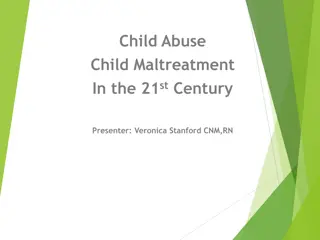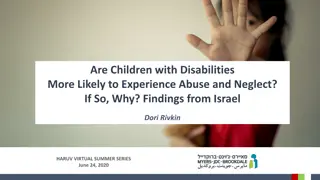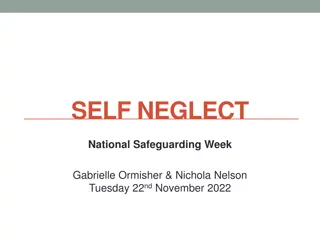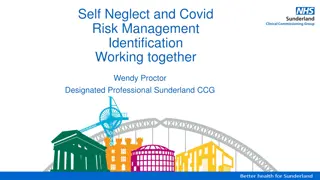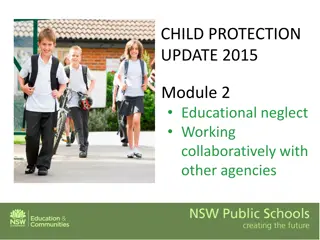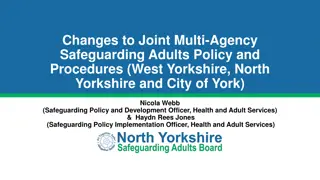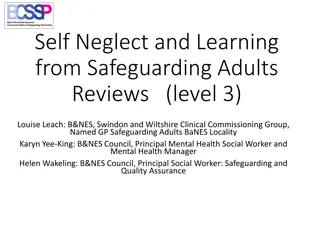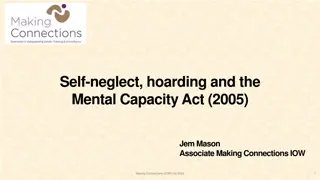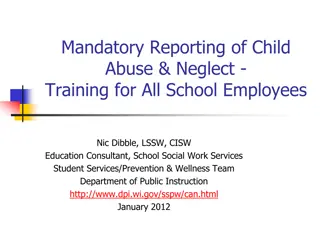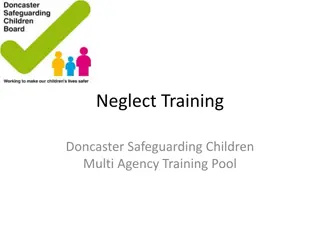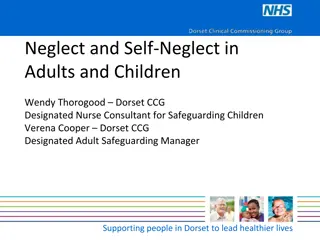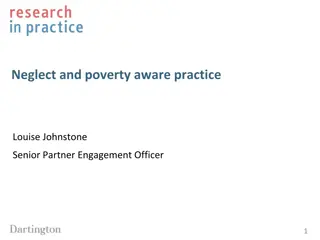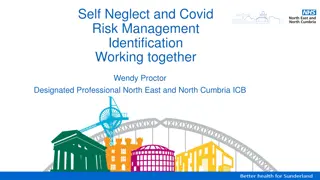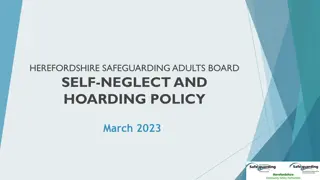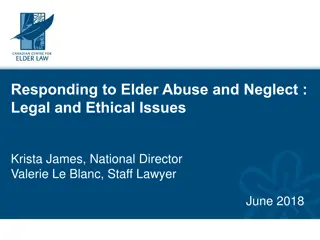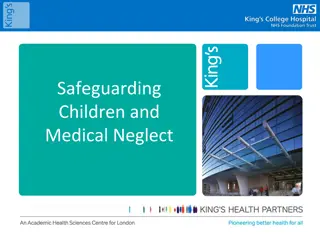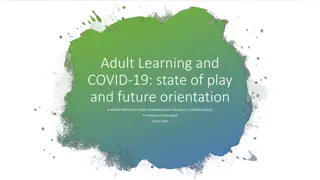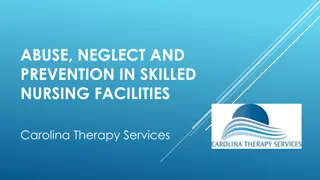Understanding Adult Self-Neglect: Evidence-Based Practices and National Analysis
The evidence base for working with adults who self-neglect reveals key insights from safeguarding adult reviews, emphasizing the prevalence of self-neglect as a form of abuse or neglect. Case reviews highlight system failures and areas for improvement, such as legal literacy and coordination shortcomings. National analysis findings point to gaps in assessment, recognition, and exploration of safeguarding options, urging a more comprehensive approach to addressing self-neglect. Emphasis is placed on a holistic understanding within the broader legal and policy context, advocating for direct practice centered around the individual.
Download Presentation

Please find below an Image/Link to download the presentation.
The content on the website is provided AS IS for your information and personal use only. It may not be sold, licensed, or shared on other websites without obtaining consent from the author. Download presentation by click this link. If you encounter any issues during the download, it is possible that the publisher has removed the file from their server.
E N D
Presentation Transcript
Professor Michael Preston-Shoot Mid and West Wales SAB 19thNovember 2021
The evidence-base for working with adults who self-neglect Learning from individual safeguarding adult reviews Analysis of 340+ reviews in England Much smaller numbers in Wales and Scotland National SAR Analysis April 2017 March 2019 98% response rate from SABs 231 SARs in the sample 45% focus on self-neglect Self-neglect the most frequent type of abuse or neglect reviewed
Self-Neglect Definition lack of self-care neglect of personal hygiene, nutrition, hydration, and health, thereby endangering safety and well-being, and/or lack of care of one s environment squalor and hoarding, and/or refusal of services that would mitigate risk of harm. A variety of key episodes fire deaths, drugs and alcohol abuse, infections from poor tissue viability, impact of mental distress or learning disability, multiple exclusion homelessness, untreated diabetes
Case reviews find shortcomings across the system Failure of escalation & challenge to poor service standards Failure to think family Lack of leadership and coordination Legal literacy Assessments of mental capacity and risk Failures of communication and information- sharing Learning about working together Collective omission of the mundane and the obvious Work on uncoordinated parallel lines
National Analysis Findings Lack of assessment of capacity, risk, care and support Assumptions of lifestyle choice Not recognised Assessment relying on self- report Not understood or explored Safeguarding enquiries not used Legal options unexplored and policies neglected Service refusal unexplored Lack of curiosity
Whole system understanding Broader legal, financial and policy context Governance policy oversight Organisational support for team members Team around the person Direct practice The person
Direct practice best practice Assessment of care & support, and mental health Person-centred, relationship- based practice Professional curiosity (history) Transitions opportunities not cliff edges Assessment & review of risk and capacity Family involvement (think family) Balancing autonomy with a duty of care Availability of specialist advice Legal literacy
Inter-organisational environment best practice Guidance on balancing autonomy with a duty of care Information- sharing & communication Working together on complex, stuck and stalled cases Use of multi- agency meetings and safeguarding enquiries Clear roles and responsibilities (lead agencies and key workers) Shared record- keeping
Organisational environment best practice Development, dissemination & review of guidance Clarifying management responsibilities and oversight Staffing, supervision, support & training Culture of openness, challenge and escalation Commissioning & contract monitoring Recording standards
SAB governance best practice Audit & quality assurance of what good looks like Review of Multi-agency training management of SARs Use of SARs to inform policy development, practice audits and training Workplace as well as workforce development Continual review of outcome of recommendations
East Sussex SAB: Mr A - a pen picture Died 24thJuly 2016, aged 64, Kent resident, no family contact Medical history: Korsakoff Syndrome, arteriovenous malformation, epilepsy, encephalopathy, type 2 diabetes, and bilateral leg cellulitis & ulceration Placed in nursing care in East Sussex Sept 2015, commissioned by West Kent CCG: no suitable local placement, placement search ongoing, no suitable alternative Placement (and DoL) in best interests as deemed to lack capacity to decide where to live Supported in decision-making by a former colleague with LPA Self-neglect: refusal of care and treatment Cause of death: systemic sepsis, cutaneous & soft tissue infection of legs, diabetes mellitus, idiopathic hepatic cirrhosis
Mr A: Recommendations Mental capacity & mental health (7) Safeguarding (2) Case coordination (6) Advocacy (1) Strengthen how agencies work together Dissemination of learning (4) Placements (3)
Using the voice of lived experience (SAR - Ms H and Ms I Tower Hamlets SAB) In the context of people s experiences of multiple exclusion homelessness and self- neglect, the notion of lifestyle choice is erroneous. The problem is not the problem; it is the solution that is the problem. Tackling symptoms is less effective than addressing causes. Attempting to change someone s behaviour without understanding its survival function will prove unsuccessful. The problem is a way of coping, however dysfunctional it may appear. Too often we are responding to symptoms and not causes. Put another way, individuals experiencing multiple exclusion homelessness are in a life threatening double bind, driven addictively to avoid suffering through ways that only deepen their suffering. At times she could not help herself because of the feelings that were resurfacing; access to non-judgemental services was vital and helpful, and that support is especially important when individuals are striving to be alcohol and drug free. It was during these times that stress, anxiety and painful feelings could bubble up , prompting a return to substance misuse to suppress what it was very hard to acknowledge and work through. Making Safeguarding Personal is not just about respecting the wishes and feelings that an individual expresses. He reflected on the challenge of knowing when to allow a person freedom of movement and when, for their own benefit, to curtail or supervise this. He described this as a moral question. It is indeed a question that, in a multi-agency and multi-disciplinary forum, needs to be answered in each unique situation, drawing on an analysis of risks and mental capacity.
Andy: a pen picture Andy died aged 32 at home. He required treatment for throat swelling, diabetes and renal failure; he did not always comply with his insulin regime or attend dialysis appointments. His living conditions in private rented accommodation were poor but his engagement with efforts to improve his housing situation was intermittent. He was living in poverty but his engagement with efforts to improve his financial situation was intermittent. He was known to self-neglect and to be hard to consistently engage. There was a pattern of rejecting assessments and treatment, followed by case closure. There are references to concerns about low mood and depression. He lived alone. There was some support/contact with a friend and family members. There are references to family dynamics.
Key emergent themes Hospital discharges Use of policies & procedures Mental capacity assessments Responses to lack of engagement Safeguarding Responses to risk of self- neglect Assessment Recording Case closure Working together Prevention of health decline Learning
Milton Keynes Adult B (2019) Adverse childhood experiences; substance misuse as response to trauma Unable to sustain hostel place due to substance misuse Unplanned hospital discharges Adult Social care assessments of his needs arising from autism and homelessness delayed and incomplete at time of death No lead agency or practitioner championing his unmet underlying needs Lifestyle and health concerns mount with no signs of professional scrutiny no professional curiosity No mental capacity assessment or full safeguarding assessment No use of advocacy or escalation of concerns Lack of inter-agency response including multi-agency meetings Lack of management guidance, direction and supervision
Isle of Wight Howard (2018) Homeless single adult without local family support Impact of adverse life events Longstanding alcohol misuse and physical ill-health Hospital and prison discharges to no fixed abode Police and ambulance crews concerned about risks of financial and physical abuse, and his self-neglect Refused housing as not regarded as in priority need No wet hostel available Referrals to adult safeguarding do not prompt multi-agency meetings or investigation; no completed Care Act 2014 care and support assessment No lead agency or key worker; no risk assessment or mitigation plan
Carol (2017) Teeswide SAB Attacked and murdered by two teenage girls Lack of understanding of coercive and controlling behaviour, of risk from others Long history of chronic alcohol use, mental health problems and vulnerability and had been identified as having multiple care and support needs Multiple agencies involved Diagnosed with a personality disorder - primarily Emotionally Unstable Borderline Personality Disorder (EUPD). Carol was therefore considered to have a dual diagnosis. Identified The need to develop or modify existing treatments to better meet the special needs of personality disordered substance abusers with therapeutic attention to reduce the severity of the substance abuse and other associated psychiatric problems such as depression, anxiety, paranoia
MS: City of London & Hackney SAB (2021) MS died, aged 63. Cause of death was acute myocardial infarction, coronary artery atherosclerosis and aspiration pneumonia. He died at a bus stop in the London Borough of Hackney where he had been living and sleeping for several weeks. MS was Turkish (Kurdish ethnicity) with limited understanding of English and a history of homelessness, self-neglect and substance abuse. He had returned to the bus stop where he eventually died at the end of May 2019, having spent the previous five months in a nursing home. When that placement came to an end he was offered a hotel room but declined. He is reported as having said that something brings [me] back to the bus stop. There were discussions on whether and how to use anti-social behaviour powers, and mental capacity and mental health legislation, in order to safeguard his health and wellbeing, and to address expressed concerns from local residents. No effective means of resolving the situation was found before Musa died. Referred adult safeguarding concerns did not lead to a section 42 enquiry
How? Why? Research pinpoints: Client characteristics leading to neutralisation of moral concerns Unconscious bias Lack of wrap-around integrated provision to respond to trauma and adverse life experiences Desensitisation Complexity of work exacerbated by constraints Policy overload, time and workload pressures Complexity of legal mandates Multi-agency working grafted onto single agency structures
Final Observations We have an evidence-base; we know what positive, good practice looks like. We need to focus on what facilitates and what blocks necessary change to get to good across the four domains of the evidence-base. How embedded is guidance, for example in supervision and decision-making? Emphasis on training but outcomes, if captured, variable and less emphasis on workplace development. No requirement to have local learning and service development strategies. Difficulty of obtaining SARs limits learning. Law seen as difficult to use; ethics difficult to navigate; few organisational spaces for reflection. Has the Care Act helped in England inclusion of self-neglect, duty to cooperate, duty to review; but absence of power of entry & protection orders, impact of parallel processes and financial austerity, and limited requirements to publish findings?
Summary of research findings: practitioner approaches Practice with people who self-neglect is more effective where practitioners Build rapport and trust, showing respect, empathy, persistence, and continuity Seek to understand the meaning and significance of the self-neglect, taking account of the individual s life experience Work patiently at the pace of the individual, but know when to make the most of moments of motivation to secure changes Keep constantly in view the question of the individual s mental capacity to make self- care decisions Communicate about risks and options with honesty and openness, particularly where coercive action is a possibility Ensure that options for intervention are rooted in sound understanding of legal powers and duties Think flexibly about how family members and community resources can contribute to interventions, building on relationships and networks Work proactively to engage and co-ordinate agencies with specialist expertise to contribute towards shared goals
Summary of research findings: organisational approaches Effective practice is best supported organisationally when Strategic responsibility for self-neglect is clearly located within a shared interagency governance arrangement such as the SAB Agencies share definitions and understandings of self-neglect Interagency coordination and shared risk-management is facilitated by clear referral routes, communication and decision-making systems Longer-term supportive, relationship-based involvement is accepted as a pattern of work Training and supervision challenge and support practitioners to engage with the ethical challenges, legal options, skills and emotions involved in self-neglect practice
Discussion How prominent are reviews in informing your day-to- day practice? How prominent is learning from reviews in informing your team s practice? How often might you and your colleagues discuss learning from reviews? How will you ensure that available guidance is used?
Journal articles Braye, S., Orr, D. and Preston-Shoot, M. (2011) Conceptualising and responding to self- neglect: challenges for adult safeguarding , Journal of Adult Protection, 13, 4, 182-193. Braye, S., Orr, D. and Preston-Shoot, M. (2015) Learning lessons about self-neglect? An analysis of serious case reviews , Journal of Adult Protection, 17, 1, 3-18. Braye, S., Orr, D. and Preston-Shoot, M. (2015) Serious case review findings on the challenges of self-neglect: indicators for good practice , Journal of Adult Protection (17, 2, 75- 87). Preston-Shoot, M. (2016) Towards explanations for the findings of serious case reviews: understanding what happens in self-neglect work, Journal of Adult Protection, 18(3), 131-148. Preston-Shoot, M. (2017) On Self-Neglect and Safeguarding Adult Reviews: Diminishing Returns or Adding Value? Journal of Adult Protection, 19(2), 53-66. Preston-Shoot, M. (2018) Learning from Safeguarding Adult Reviews on self-neglect: addressing the challenge of change. Journal of Adult Protection, 20 (2), 78-92. Preston-Shoot, M.(2019) Self-neglect and safeguarding adult reviews: towards a model of understanding facilitators and barriers to best practice. Journal of Adult Protection, 21 (4), 219- 234. Preston-Shoot, M. (2020) Safeguarding Adult Reviews: informing and enriching policy and practice on self-neglect. Journal of Adult Protection, 22 (4) 199-215. Preston-Shoot, M., Braye, S., Preston, O., Allen, K. and Spreadbury, K. (2020) National SAR Analysis April 2017 March 2019: Findings for Sector-Led Improvement. London: LGA/ADASS.
Key contacts Please contact me if you have any queries: Professor Michael Preston-Shoot, michael.preston-shoot@beds.ac.uk


